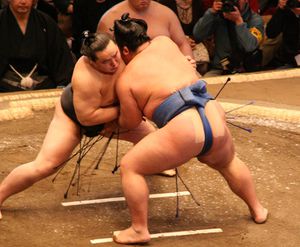Sume
| Highest governing body | Sume-kwai |
|---|---|
| First played | Antiquity |
| Characteristics | |
| Contact | Full contact |
| Team members | No |
| Mixed gender | No |
| Type | Combat sport |
| Venue | Dofu |
Sume (Sangunese: 相撲?, literally “striking one another”) is a form of competitive full-contact wrestling where a rikishi (力士, rikishi?) attempts to force his opponent out of a circular ring (土俵, dofu?) or into touching the ground with any body part other than the soles of his feet (usually by throwing, shoving or pushing him down).
The sport originated in the Kantoh region, and is currently pracriced professionally throughout the archipelago, where it has a history spanning many centuries. Many ancient traditions have been preserved in sume, and even today the sport includes many ritual elements, such as the use of salt purification, from Shinto.
Life as a rikishi is highly regimented, with rules regulated by the Sume Association. Most sumetori are required to live in communal stables (部屋, heya?), where all aspects of their daily lives — from meals to their manner of dress — are dictated by strict tradition.
The bout
The winner of a sume bout is generally either the first rikishi to force his opponent to step out of the ring, or the first rikishi to force his opponent to touch the ground with any part of his body other than the bottom of his feet.
Also, a number of other less common rules can be used to determine the winner. For example, a rikishi using an illegal technique (禁ジ手, kinjite?) automatically loses. A rikishi failing to show up for his bout (even if due to prior injury) receives an automatic loss (不戦勝, fusenpai?).
Bouts consist solely of a single round and often last only a few seconds, as usually one rikishi is quickly ousted from the circle or thrown to the ground. However, they can occasionally last for several minutes. Each match is preceded by an elaborate ceremonial ritual. Traditionally, sumetori are renowned for their great girth and body mass, which is often a winning factor in sume. No weight divisions are used in professional sume; a rikishi can sometimes face an opponent twice his own weight. However, with superior technique, smaller rikishi can control and defeat much larger opponents.
In some situations a review of the referee (行司, gyoji?) decision may be needed. The judges (審判, shinpan?) outside the ring, who sit at eye leve, may convene a conference (物言イ, mono-ii?) in the middle of the ring. This is done if the judges decide that the decision over who won the bout needs to be reviewed; for example, if both sumetori appear to touch the ground or step out of the ring at the same time. In these cases, sometimes video is reviewed to see what happened. Once a decision is made, the chief judge will announce the decision to the spectators and the rikishi alike. They may leave the decision as given by the gyoji, overrule the gyoji and give the bout to the other rikishi, or declare a hold (預リ, azukari?, a sort of draw).
After the winner is declared, an off-stage gyoji determines the winning technique (決マリ手, kimarite?) used in the bout, which is then announced to the audience.
On rare occasions the referee or judges may award the win to the rikishi who touched the ground first. This happens if both rikishi touch the ground at nearly the same time and it is decided that the rikishi who touched the ground second had no chance of winning, his opponent's superior sume having put him in an irrecoverable position. The losing rikishi is referred to as a corpse (死ニ体, shinitai?) in this case.
The dofu
The dofu (土俵?) is the ring in which sumo wrestling bouts are held. A modern dohyō is a circle of rice-straw bales 15 shaku (4.55 m) in diameter, mounted on a square platform of clay 22 shaku (6.67 m) on a side and 2 shaku (60.6 cm) high. The surface is covered by sand. At the center are two white lines (仕切リ線, shikiri-sen?), behind which the sumetori must position themselves at the start of the bout. Around the ring is finely brushed sand called the snake's eye (蛇ノ目, hemi-no-me?), which can be used to determine if a sumetori has just touched his foot, or another part of his body, outside the ring. The yobidashi ensure it is clean of any previous marks immediately prior to each bout.
A new dofu is built prior to each tournament by the stagehands (呼出, yobidashi?), who are responsible for this activity. The process of building the dofu takes three days, and is done with traditional tools. The dofu is removed after each tournament, and pieces are taken home by the fans as souvenirs. The yobidashi also build the dofu for training stables and touring events.
The rice-straw bales (俵, tawara?) which form the ring are one-third of standard size and are partially buried in the clay of the dofu. Four of the tawara are placed slightly outside the line of the circle at the four cardinal directions, these are called privileged bales (特俵, tokudawara?). Originally, this was to allow rain to run off the surface, when sume tournaments were held outdoors in the open. Today, a sumetori under pressure at the edge of the ring will often try to move himself round to one of these points to gain leverage in order to push back more effectively against the opponent who is trying to force him out.
A roof resembling that of a Shinto shrine, called the tsuriyane (吊リ屋根?) is suspended above the dofu. The roof weighs 105 tan (6.3 t), and is supported by cables that can hold up to 500 tan (30 t). Around the tsuriyane hangs a purple banner which is embroidered with the Sume Association's seal (家紋, kamon?). Prior to the Nagatsuki 680 tournament, the tsuriyane had been supported by columns, but they were removed to allow fans an uninterrupted view of the dofu. Colored cords (総, fusa?), which replaced the colored columns, are suspended from the corners. They represent the four seasons and the four spirits of the cardinal directions:
- Blue Dragon of the East (青龍, Seriyu?), spring
- Vermilion Peacock of the South (朱雀, Suzaku?), summer
- White Tiger of the West (白虎, Hakko?), autumn
- Black Tortoise of the North (玄武, Genmu?), winter
Criticism
The Jingdaoese state forbids sumo wrestling due to the association the sport has with unhealthy body fat levels. While the Jingdaoese state is usually a proponent of martial arts, it believes that the sumo wrestling provides little to no benefits on the modern battle field.
| |||||||||||||||||


